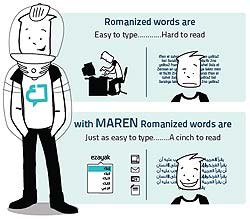REDMOND, Wash — March 5, 2010 — Mostafa Ashour thinks communicating in his native Arabic makes all the difference, especially when it comes to passionate topics—soccer, for instance.

Mostafa Ashour, Microsoft Maren program manager.
Ashour is a program manager for Microsoft Maren, a new transliteration tool that allows users to communicate in traditional Arabic while typing on a Roman alphabet keyboard.
“Expressing your intense feelings of joy or sorrow is better served using your native tongue,” Ashour says. “Maren helps you communicate efficiently in Arabic, even if you lack access to an Arabic keyboard or you are not familiar with one.”
It would seem that Roman keyboards would make it nearly impossible to type in Arabic, an entirely different writing system with its own characters, symbols, and right-to-left connected cursive style. But for the past two decades, a cultural phenomenon has boomed nearly in step with the Internet—the use of Romanized Arabic text. This happens when Arabic language speakers, who are unfamiliar with or unable to find an Arabic keyboard, use the Roman alphabet, numbers, and symbols to represent words from the Arabic language.
Using a Roman keyboard to type Arabic creates text that initially looks like this: Ahlan waSahlan fi 3alam Maren (Welcome to the world of Maren). Translated by Mare into true Arabic, this sentence looks like أهلا وسهلا في عالم مرن.
Using Maren, a fully integrated Windows extension, users can thus type Arabic in real time using Roman characters.
Because Maren is a download rather than a Web-based tool, users don’t have to rely on an Internet connection to be able to transliterate, Ashour says. In addition, Maren works across all Windows applications. Users can compose documents, blogs, e-mails, instant messages, or even leave comments on friends’ Facebook pages—all in traditional Arabic.

Using Maren, users can write Arabic in any application using a Roman keyboard and have it converted on the fly to native Arabic script.
“The problem is, it’s very easy to write Arabic in Roman letters but very painful to read it this way,” Ashour says. “Using Maren, you can write Arabic in any application using a Roman keyboard and have it converted on the fly to native Arabic script for easier reading.”
Response to the product has been positive, he says, pointing to 150,000 downloads in the first few months and favorable reviews of Maren in the blogosphere and tweetosphere.
Ashour says it was rewarding to work on something that was both culturally and occupationally significant.
“It’s been really interesting to work on something that can have such an impact on people’s lives,” Ashour says.





